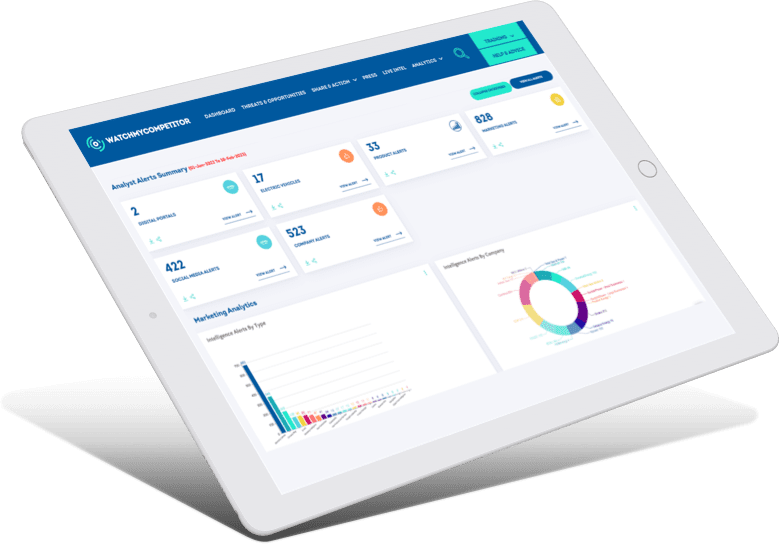In today’s digital landscape, where a company’s online presence serves as its virtual storefront, the importance of website monitoring cannot be overstated. As businesses strive to provide seamless user experiences, optimise performance, and respond to ever-evolving customer demands, website monitoring emerges as a cornerstone practice.
As you read on, we’ll be looking at just what website monitoring is all about and how you can put website monitoring best practices into action.

Why Monitor Your Competitors’ Websites?
The realm of business has moved beyond physical boundaries and has now become a virtual arena, where every click and interaction holds immense value. Competitor website monitoring stands as a strategic imperative, allowing businesses to not only keep pace with their rivals but also outmanoeuvre them.
This process involves the tracking of competitors’ online activities, unearthing their strategies, recognising their strengths, and identifying their weaknesses. The insights gleaned from this monitoring provide an invaluable competitive edge.
Beyond the traditional competitive analysis, monitoring competitors’ websites is similar to being given an insight into their digital boardroom discussions. It uncovers trends, and strategies, and empowers businesses to capitalise on emerging opportunities.
Through this proactive surveillance, businesses can adapt swiftly, refine their tactics, and seize untapped market segments. Competitor website monitoring is not just about staying informed; it’s about driving innovation and achieving sustained success in a rapidly changing digital landscape.
The 7 Website Monitoring Best Practices
1) Spend time setting up targeted monitoring
Rushing through the setup phase can lead to costly oversights. Collaborating with experts, such as engineers and developers, is pivotal in constructing a monitoring framework that aligns with your business objectives. Acquiring their input ensures a robust and intuitive monitoring structure, accessible even to non-technical team members.
The focus should be on metrics directly affecting user experiences and key performance indicators (KPIs). For instance, e-commerce websites might prioritise average first-time render speeds to prevent bounce rates, while uptime/downtime checks are vital for all sites.
2) Focus on key pages & functions
Website monitoring is most effective when concentrated on pages and elements with the highest impact. Every website hosts a selection of pages, but not all have the same influence on user engagement and conversion.
Dedicating resources to monitor landing pages, product pages and checkout processes is the best approach. By mapping user journeys and identifying pivotal checkpoints, businesses can tailor monitoring efforts to the heart of the user experience.
Take the example of an e-commerce website. Monitoring the functionality of the cart button, the ‘see cart’ and ‘checkout’ pages becomes paramount. These pages directly influence conversion rates and revenue generation.
Employing insights tools to analyse user engagement at these stages provides an understanding of user behaviour and allows businesses to pre-emptively address issues.
3)Use website monitoring tools
Website monitoring tools play a crucial role in maintaining the health and performance of your online platform. Although manual monitoring is an option, it’s not the most efficient or practical approach for comprehensive oversight.
Embracing automated monitoring tools significantly simplifies the process, guaranteeing both precision and efficiency. These tools evaluate server functionality, gauge user experiences and compile valuable user behaviour data, providing a holistic view of your website’s performance.
4) Combine synthetic & real-user monitoring
Website monitoring embraces a dual approach: synthetic monitoring and real-user monitoring. Synthetic monitoring employs automated checks conducted by servers in various locations to assess backend performance, server availability, and configurations. It offers a bird’s-eye view, detecting bugs and issues at the source.
Complementing synthetic monitoring with real-user monitoring (RUM) augments this perspective by gauging how real users across diverse browsers and locations experience site performance. The combining of these approaches provides a comprehensive understanding of both technical operations and user satisfaction.
5) Go beyond averages
Metrics are often summarised through averages, providing a convenient overview. However, relying solely on averages can be deceptive. Diving deeper into individual user experiences and percentages reveals issues that might be missed at first glance.
Consider the scenario where the average load time is 2.1 seconds—a seemingly positive result. However, beneath this average, a subset of users experiences slower loading times. This disparity might indicate compatibility issues with specific browsers or devices. Monitoring beyond averages is essential to detect such anomalies and ensure a consistently positive user experience.
6) Utilise historical data
Historical data, spanning previous website performance tracking and iterations, is a treasure trove of insights. By examining performance trends, businesses can identify drops in performance, establish baselines and derive actionable intelligence.
Comparative analysis of monitoring data across distinct time frames unveils performance trends and patterns. These patterns can be correlated with metrics such as bounce rates, session durations, and user satisfaction indices.
Historical data empowers businesses to benchmark internal performance over time, facilitating early intervention in response to performance drops.
7) Set up streamlined alerts
Effective website monitoring is proactive, not reactive. Setting up alerts for potential issues is instrumental in swift resolution. However, inundating team members with alerts can lead to complacency.
Streamlining alerts ensures that pertinent information reaches the relevant stakeholders promptly, minimising downtime and disruptions.
Alerts should not merely serve as notifications but also as actionable insights. Including detailed information and links that aid in diagnosing and resolving issues expeditiously is essential. This streamlined approach ensures that website monitoring remains a robust shield against potential disruptions.
Using WatchMyCompetitor for Your Website Monitoring
Using WatchMyCompetitor (WMC) for your website monitoring can give you a significant competitive advantage. WMC provides real-time updates on your competitors’ websites, including new content, pricing changes and marketing campaigns. This intelligence can help you identify new opportunities, stay ahead of the competition and make better strategic decisions for your own business.

Automated tracking: WMC automatically tracks your competitors’ websites 24/7, so you don’t have to spend time manually checking them.
Competitor analysis: WMC provides detailed analysis of your competitors’ websites, including their traffic, engagement, and social media performance.
Custom alerts: You can set up custom alerts to be notified when your competitors make changes to their websites.
Final Thoughts
Website monitoring is essential for businesses in today’s digital world. It’s not just about keeping your website up and running, it’s about creating a great user experience, generating conversions and staying ahead of the competition.
By applying the 7 website monitoring best practices as mentioned and the relevant industry tools, businesses can get real-time insights into their website performance and make informed decisions about how to improve it.
Website Monitoring Best Practices FAQs
How does website monitoring contribute to better SEO rankings?
Website monitoring is intertwined with SEO success. Search engines prioritise websites that deliver exceptional user experiences, rapid load times and seamless navigation. By proactively identifying and addressing issues through monitoring, businesses create a virtuous cycle of positive user experiences, translating into improved SEO rankings.
How often should I perform website monitoring checks?
The frequency of monitoring checks hinges on factors such as industry dynamics, website traffic and business goals. For comprehensive insights and timely issue detection, weekly monitoring checks are recommended. High-traffic websites might necessitate daily monitoring to uphold performance standards.

